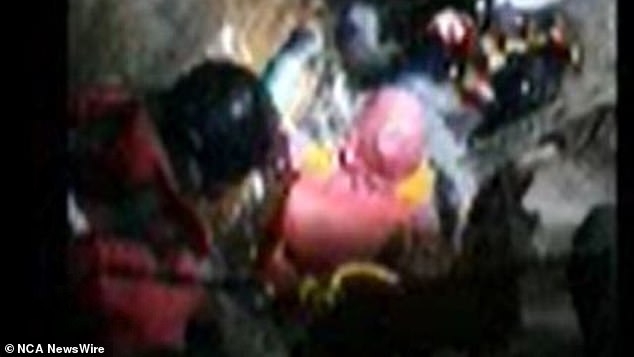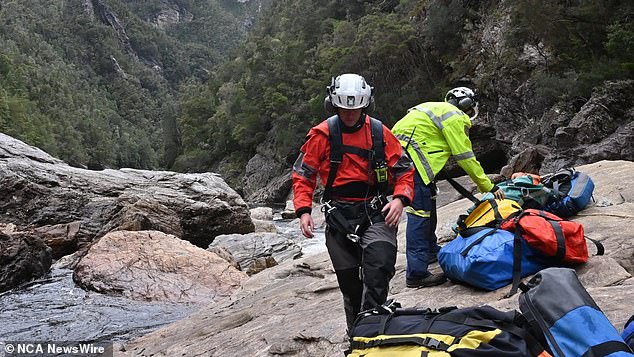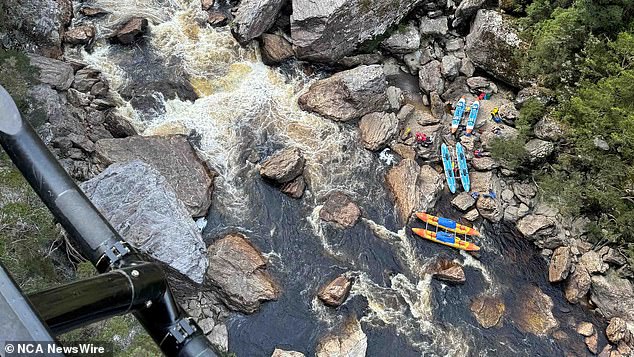Harrowing update on tourist who spent 20 hours trapped between rocks during whitewater expedition on Tasmania’s Franklin River as distressing details of the major rescue emerge
A Lithuanian tourist is fighting for his life after his leg was amputated in an attempt to save his life during a dramatic 20-hour whitewater rescue in Tasmania.
The 69-year-old Lithuanian man remains in critical condition in hospital following a dramatic rescue operation Saturday after he became stuck among rocks on the Franklin River a day earlier.
The man – who has fifty years of experience in whitewater rafting – had been on the river with a group of friends from Lithuania when he slipped on a rock and trapped his leg underwater.
When rescuers ran out of options after several failed attempts to free him, and fearing his condition was deteriorating, the decision was made to amputate his leg above the knee.
Tasmania Police Officer Callum Herbert said the rescue efforts were one of the most intense scenarios he has ever seen in the region.
“Most entrapments would be simpler than this,” he said.
‘This patient was so trapped that a limb was amputated.
“It’s pretty much the worst case scenario you can get, short of drowning.
The 69-year-old man was kayaking when he slipped and fell into the water and became stuck between the rocks. Photos: Tasmania Police

It took 20 hours for rescuers to free the man. Photos: Tasmania Police
‘He fell into the river in an awkward position.
“The circumstances where he couldn’t be physically removed, every angle available to manipulate him out and every angle available.
Surf Life Saving Tasmania swift water rescue technician Ace Petrie praised the man and his crew for their efforts during the challenging rescue.
“His rafting crew did a great job of securing him as best they could,” Mr Petrie said.
“He was kind of stuck, I would describe it as an hourglass, with his knee stuck in the rocks in a deep part of that rapid.
“There were a number of hazards that we had to deal with and work around in order to gain access to the patient and make a further assessment of his entrapment.
“That rapid was moving quite quickly, the water level for the Franklin River was half of what it normally was.”
Mr Petrie said the rescue was hampered by the “very dynamic, changing, dangerous environment” they all found themselves in.
“We would have liked to have the river as low as possible, that probably would have made the extrication a little bit easier,” he said.
‘We were lucky that the weather was very kind to us and that the water level as such did not rise, which would have changed the complexity.
“At the time he went in, it was about chest height.
‘As the hours passed, the water level dropped, but it didn’t drop fast enough as we would have liked.
‘I was quite surprised by the water temperature. It wasn’t as cold as it can certainly be in winter.’

Rescue teams at the Franklin River in southwestern Tasmania have worked for a long time to free the Lithuanian. Photos: Tasmania Police
Deciding to amputate
The decision was made by medical professionals and in consultation with the man, allowing him to be found safe and transported to the Royal Hobart Hospital.
Mr Petrie said efforts to free the man were arduous, with rescuers even trying to use the jaws of underwater rescue equipment.
After assessing his entrapment, we started with basic scenarios using ropes and pulleys.
“We didn’t move these rocks at all, this took about 10-12 hours,” he said.
‘We had to get that equipment into the water, it was flowing quite fast and that made it difficult to get it stable at that moment.
‘Everyone wanted this man out. We didn’t give up.’
Another issue that proved challenging for the rescue crew was the man’s lack of English.
“He spoke some broken English, for example when we tried to pull his leg out he could say, ‘My leg is broken’ or ‘broken leg’, but some of that we couldn’t deduce from the situation by talking to him about his family or the travels he had made,” Mr. Petrie said.
“That was really difficult.”
Fortunately, one of the men’s traveling companions was a Lithuanian doctor who was able to translate some of the medical information needed before it was decided that amputation was the only option.
“The complexity of amputations anywhere is significant,” Ambulance Tasmania intensive care paramedic Mitch Parkinson said.
“There’s an incredible ethical (and) legal component to that discussion and then we expose the complexities required to effect his rescue and it’s in broken English and shared through a Lithuanian translator.
“We have done our best to convey the reality of his entrapment.
“When it came to discussing the reality of his entrapment and the decisions that were being made in real time and the decisions that could be made the next morning, he was an exceptional resource for us and we benefited greatly from having him present was.
“There was a realization that every conceivable effort was being made due to the sheer number of technicians in place and the resources available in remote Tasmania. This was not a discussion or a decision made lightly, but one made with the breadth of information and resources we had. was available to us.’

The man was rafting with a group of friends when disaster struck. Photo are emergency workers during the rescue operation
Mr Parkinson said the man’s outlook on the whole situation was remarkable and he remained ‘exceptionally strong and robust’ throughout the ordeal.
“He maintained an exceptionally resilient disposition all night and was tired all morning,” he said.
This was an exceptionally long mission.”
Tasmanian Police Acting Assistant Commissioner Doug Oosterloo previously said a huge effort had gone into the mission to help the man.
“This rescue was an extremely challenging and technical operation and an incredible effort over many hours to save the man’s life,” he said.
‘Every effort was made to get the man out before he made the difficult decision to amputate his leg.
‘The professionalism and commitment of all care providers deserves praise.’
How the ordeal unfolded
The man was kayaking with friends in a private tour group Friday afternoon when his leg got stuck between rocks in the rapids, trapping him.
About an hour later, his smartwatch called the emergency services.
Rescuers from Ambulance Tasmania, Tasmania Police, Surf Life Saving Tasmania, the SES and the Tasmania Fire Service came to his aid.

Scene from the Franklin River rescue where a man in his 60s became trapped and had his leg amputated. Photo: Tasmania Police
And over the next twenty hours, repeated attempts were made to free him, but all were unsuccessful.
During the rescue operation, the man remained partially submerged.
And when further attempts to free him on Saturday were unsuccessful, the decision was made to amputate his leg so he could be brought to safety.
“The operation was successfully carried out by the medical team using specialist equipment,” Tasmania Police said.
